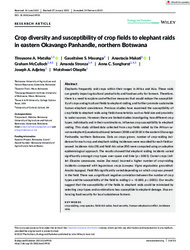Seasonal Variation in Home Range Sizes and Daily Distance to Ephemeral Surface Water for African Savannah Elephant (Loxodonta africana) in Eastern Okavango Panhandle, Northern Botswana.
Date
2025-01Author
Makati, Anastacia A.
Songhurst, Anna
Bennitt, Emily
Masunga, Gaseitsiwe S.
McCulloch, Graham
Stronza, Amanda
Matsika, Tiroyaone A.
Eckardt, Frank D.
Metadata
Show full item recordAbstract
African elephants (Loxodonta africana) are megaherbivores of the African savannas requiring extensive ranges that can provide critical resources for their survival and reproduction at different spatiotemporal scales. We studied seasonal differences in home range sizes and daily distance to the nearest surface water sources by five male and 10 female African elephants in the eastern Okavango Panhandle in northern Botswana between 2014 and 2017. We hypothesized that (i) elephant home ranges would be larger in the wet than in the dry season (because critical resources tend to be less localized in the wet than in the dry season), (ii) the daily distance of the elephants to the nearest ephemeral surface water sources would be larger in the dry than in the wet season because many of the ephemeral water sources would be dry in the dry season and elephants would start moving towards permanent water sources such as rivers, and lastly (iii) that the differences in elephant home ranges and daily distance to water would differ between sexes. Our results showed that elephant home ranges were larger in the wet than in the dry season, and that they differed between sexes with female elephants having smaller home ranges in the late wet season. The mean daily distance to the nearest ephemeral surface water sources was larger in the dry than in the wet season. There was an inverse relationship between elephants' daily distance to permanent surface water and to ephemeral water sources. The findings indicate the need for large conservation areas and functional connectivity between landscapes to enable the highly mobile savanna elephants to access critical seasonal resources such as water and forage in semi-arid savannas. Such landscapes are critical, especially in the face of climate change, when high air temperatures and droughts may exacerbate forage and water shortage and intensify human–elephant interactions in surrounding agroecosystems.
Collections
- Research articles [88]

